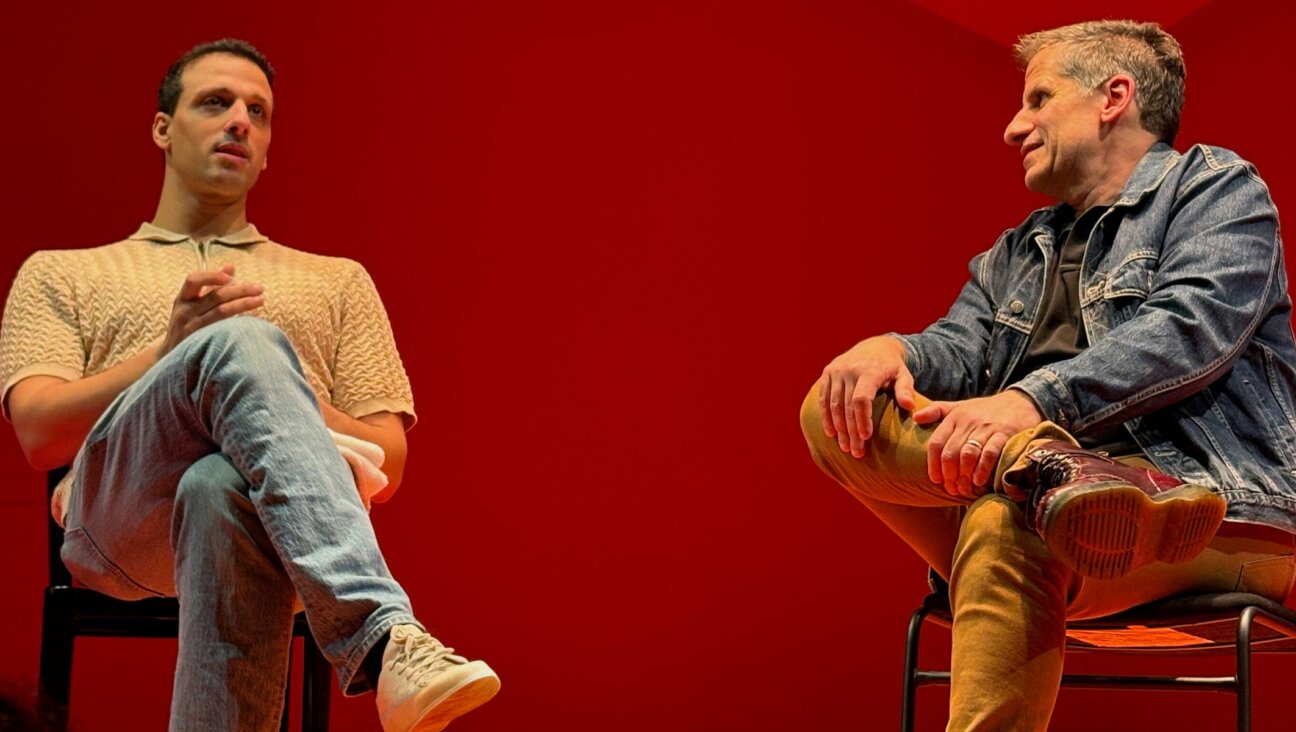The Essential Jewishness Of Carol Channing — And Lorelei Lee

Carol Channing, Backstage Image by Getty Images
The Broadway star Carol Channing, who died on January 15 at age 97, reminded us that caricatures of genius can express humanity and vitality, encapsulating people. Channing was the daughter of Adelaide Glaser (1886–1984), of German Jewish origin. The artist Al Hirschfeld claimed that Channing, along with Zero Mostel, was one of his favorite subjects. No doubt this was because the exuberant, outsized personae of Channing and Mostel lent themselves to a shorthand of mentshlekhkeyt (humanity).
Early on, Hirschfeld drew Channing as a flapper in a revue. His drawing reportedly landed her the plum role of Lorelei Lee in the musical “Gentlemen Prefer Blondes,” (1949) one of her first stage hits. Fifteen years later, Hirschfeld’s image of her as Dolly Levi was even more iconic. An avian intensity in the staring lidless eyes was bolstered by a curvaceous form in which the lanky actress’s dimensions may have been exaggerated. So essential was caricature to Channing’s artistic personality that it is small wonder that her son Chan Lowe grew up to be an editorial cartoonist.
When she spoke of Judaism, as she did readily, Channing easily adopted the comic character of Lorelei Lee, the dizzy flapper with reserves of unsuspected force and smarts in “Gentlemen Prefer Blondes.” In 2010, at age 89, Channing informed an interviewer: “To me, [Judaism is] the most ancient religion.” While technically untrue – historians state that Hinduism is older — this attitude clearly sustained Channing during difficult times. Raised in a Christian Science household, she relied on doctors to help her to continue performing through health challenges. She would explain that a Jewish doctor enabled her survive a bout of ovarian cancer in the 1970s by advising: “If you reach to the heavens to [perform,] the heavens answer you.”
There was Yiddishkeit in some of her earliest stage-related inspirations. As a schoolgirl in 1930s San Francisco, she saw the Latvian Jewish dancer Gertrude Shurr adopt Junoesque poses akin to Diana the Huntress. Shurr was featured in “Chronicle,” an evening length ballet choreographed by Martha Graham, about the looming war in Europe. Channing never forgot this performance, and later, her statuesque bodily confidence onstage may have been drawn in part from these early brushes with the Graham technique. By the 1930s, as one Jewish Telegraphic Agency dispatch noted, “Although Miss Graham is not herself Jewish she prefers Jewish girls in her group because she finds that they are willing to work hard, practice diligently and are intelligent interpreters of the work before them.” Channing was galvanized by the dancing of this company of forceful Jewish women.
Decades later, Channing’s stage appearances were likewise enlivened by terpsichorean emotion and tradition. Some audiences just ogled her long legs, but the dynamism with which she crossed the stage was a key element of her impact as a performer, especially in “Hello, Dolly!” By contrast, Barbra Streisand moved with surprising awkwardness in the screen version of “Dolly,” even as directed by the famed dancer Gene Kelly.
Channing was inspired by more than just Jews dancing. As an expression of her world view, “Carol Channing – Larger Than Life,” Dori Berinstein’s 2011 documentary, aptly included the song “Anyone Who’s Anyone (Is Jewish)” by Bill Weeden and David Finkle. A failed early marriage to Theodore Naidish, a novelist, introduced Channing to Jewish family culture, which she greatly appreciated, especially the food.
In a 2002 memoir, she expressed fond memories of Moscowitz and Lupowitz, a Romanian-Jewish restaurant on New York’s Lower East Side. In this restaurant, which billed itself as the place “where the finest Jews come to eat,” Channing and her in-laws would delight in performances by such Yiddish theater stars as Pesach Burstein She also must have been impressed by the menu, which featured such delicacies as Broiled Brains With French Fried Potatoes and Steer Liver With Fried Onions.
A fresser in her earlier years, Channing amused a stage colleague, George Burns (born Nathan Birnbaum) when they performed in Las Vegas, by gorging on steaks stashed in her handbag when she attended performances by other entertainers. Perhaps this carnivorous diet, adopted early on at Moscowitz and Lupowitz, gave her the glowing vitality, like a psychedelic sunflower, that dimmed all other stage and screen partners around her. In the otherwise dated and peculiarly racist musical film “Thoroughly Modern Millie,” her impact overwhelmed even such skilled performers as Julie Andrews and Mary Tyler Moore.
Perhaps even more than in food and performance, Channing showed a lively interest in the Yiddish language. Despite the fact that her first marriage did not work out, she asserted: “I got to learn the whole Jewish religion, and [my husband’s family] didn’t speak English, so I learned Yiddish.” She used her linguistic ability professionally, as she explained in a 2007 interview. Arriving at the William Morris Agency, a leading showbiz office, she would demand to see the gantse macher (big shot). This technique apparently worked, and she was ushered in to audition for Abraham Isaac “Abe” Lastfogel, the macher in question. Regaling him with a Yiddish song, she impressed Lastfogel, a Russian Jewish talent agent who had fled his homeland to escape pogroms.
Was Channing’s most famous role as Dolly Levi a demonstration of closeness to Jewish tradition? Opinions differ. Theater historian Angela Pao cites Channing’s blessed simplicity in proclaiming that one becomes Jewish automatically by marrying a Jew. For Channing, her performance as Dolly Levi necessarily contained innate Yiddishkeit. In his “The Great White Way: Race and the Broadway Musical” historian Warren Hoffman disagrees, alleging that Channing’s Dolly was more ethnically “wacky” than Jewish.
Whatever niceties of cultural communication were involved, Channing was certain that assimilating Jewish tradition was an asset for her as a performing artist. With blissful naïveté, she would launch into a fictitious anecdote about Albert Einstein that is revealing about Channing’s attitude about Yiddishkeit and performance:
“When Princeton University asked [Einstein] to come there and do a lecture on how he discovered the Theory of Relativity, he brought his violin and said, ‘I’m going to do a violin concert for you. Maybe you’ll be able to see the infinite harmony that I ran into.’”
Channing’s own uniquely harmonious nature allowed her to thrive even when working with such widely loathed theater behemoths as the producer David Merrick (born David Lee Margulois). Part of the joyous harmony was her belief, however much it was based in caricature, that she had thoroughly assimilated Jewish culture.
Benjamin Ivry is a frequent contributor to the Forward.















